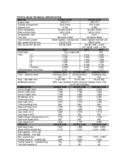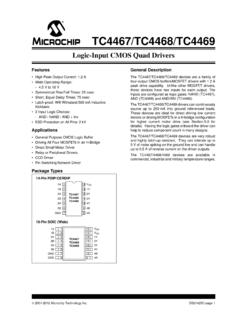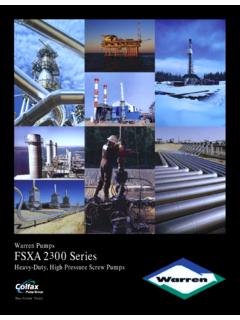Transcription of BIOFUELS - Food and Agriculture Organization
1 3. COMMODITY SNAPSHOTS. BIOFUELS . Market situation Cereals, oilseeds and vegetable oil prices in 2014 continued their decrease in nominal terms. This, coupled with the strong decline in crude oil prices in the second half of the year, led to lower world ethanol3 and biodiesel4 prices in a context of ample supply for both products. The policy environment around BIOFUELS remained uncertain, with the absence of a final rulemaking by the United States Environmental Protection Agency (EPA) for policies in 2014 and 2015, and by the fact that the European Union's 2030 Framework for Climate and Energy Policies adopted in October 2014 that did not define clear targets for BIOFUELS beyond 2020.
2 The evolution of the crude oil price and various domestic policy signals provided incentives to the Brazilian ethanol industry. Projection highlights This Outlook assumes that ethanol use in the United States will be limited by the 10%. ethanol blend wall5 and that cellulosic ethanol will not be available on a large scale until the last years of the projection period. For the European Union, the fulfilment percentage of the Renewable Energy Directive (RED)6 target coming from BIOFUELS expressed in energy share is assumed to reach 7% by In Brazil, the Outlook assumes that Brazilian retail prices of petrol over the first part of the next decade will be kept slightly above international Elsewhere in the world, biofuel sectors in general continue to be driven by a mix of price trends and effective policy support.
3 Proposed production and consumption targets vary considerably across countries leading to a wide range of growth prospects for individual countries. Decreases in crude oil and biofuel feedstock prices should lead to a strong decline in ethanol and biodiesel prices at the beginning of the projection period. Subsequently, both ethanol and biodiesel prices are expected to recover in nominal terms close to their 2014. levels (Figure ). Global ethanol and biodiesel production are both expected to expand to reach, respectively, almost and 39 billion litres (Bln L) by 2024. Food-crop based feedstocks are expected to continue to dominate ethanol and biodiesel production over the coming decade as indicated by the lack of investment in research and development (R&D) for advanced BIOFUELS , the size of the required investments and the lack of policies' visibility for operators.
4 Most of the additional ethanol production is expected to take place in Brazil. Incentives based on national biofuel policies will continue to influence biodiesel production patterns. Indonesia will surpass the United States and Brazil in the latter years of the outlook period to become the second largest biodiesel producer behind the EU. Ethanol use in the United States will be limited by the ethanol blend wall and by declining gasoline use in the latter years of the projection period. In Brazil, ethanol use expansion is linked to the high mandatory anhydrous ethanol blending requirement and to a differential taxation system that allows hydrous ethanol to compete with gasohol at least in some states.
5 In the European Union, biodiesel use is projected to increase to its highest level in 2019 when the RED target is assumed to be met. 126 OECD-FAO AGRICULTURAL OUTLOOK 2015 OECD/FAO 2015. 3. COMMODITY SNAPSHOTS. Ethanol and biodiesel trade in the next ten years is not expected to expand. The bilateral ethanol trade that occurred between Brazil and the United States is not expected to take place as the need for sugarcane based ethanol to fill the US advanced mandate should remain limited. Argentina and Indonesia continue to dominate biodiesel exports, the United States and EU are the only significant importers. The future evolution of the political will to support biofuel blending in transportation fuel represents the key uncertainty to the sector.
6 This decision process will be shaped mainly by macroeconomic developments in key countries, relative prices of feedstocks and fossil fuels, prevailing views on environmental benefits of BIOFUELS and the global food security situation. Figure Evolution of biofuel world prices Expressed in nominal terms (left panel) and in real terms (right panel). Ethanol Biodiesel Ethanol Biodiesel USD/hl USD/hl 140 140. 120 120. 100 100. 80 80. 60 60. 40 40. 20 20. 0 0. 2004 2006 2008 2010 2012 2014 2016 2018 2020 2022 2024 2004 2006 2008 2010 2012 2014 2016 2018 2020 2022 2024. Note: Ethanol: wholesale price, US, Omaha; Biodiesel: Producer price, Germany, net of biodiesel tariff and energy tax.
7 Source: OECD/FAO (2015), OECD-FAO Agricultural Outlook , OECD Agriculture Statistics (database), 1 2 The expanded BIOFUELS chapter is available at OECD-FAO AGRICULTURAL OUTLOOK 2015 OECD/FAO 2015 127. BIOFUELS . Main assumptions Policies targeting the BIOFUELS sector have been introduced in several countries since 2005 to achieve improvements in energy security, to reduce greenhouse gas (GHG). emission, to enhance export opportunities for high value added products as well as sometimes to foster rural development. They include support measures and also targets or mandates for biofuel use. In the United States, the Energy Independence and Security Act (EISA) of 2007 defined 1.
8 The Renewable Fuel Standard programme known as RFS2. Under this programme, EISA. established four quantitative annual mandates up to 2022: the total and advanced mandates that require fuels to achieve respectively at least a 20% and a 50% GHG. reduction as well as the biodiesel and the cellulosic mandates that are nested within the advanced mandate. The Environmental Protection Agency (EPA) provided on an annual basis, the minimum quantities for each of the four classes of BIOFUELS required. 2. In November 2013 the EPA made a proposal to reduce the total, the advanced and the cellulosic mandates for 2014. This proposal was based on the fact that the production capacity for cellulosic ethanol has lagged well behind the mandated quantities specified 3.
9 In EISA and that the ethanol blend wall issue represents a circumstance that warrants a reduction in the mandated volumes under the inadequate domestic supply waiver provision in the RFS2. The proposal created controversy throughout the biofuel industry resulting in the final EPA rulemaking on 2014 and 2015 mandates still not being issued. Given the lower crude oil price levels assumed in the projection and the current difficulties encountered in supplying E15 to US consumers, it is assumed that the amount of ethanol being consumed in low blend mixes in the United States will not exceed the blend wall level of 10% over the next decade. Due to decreasing gasoline use in the United States over the projection period, limitations in the expansion of domestic ethanol use related to the blend wall issue and limited development of the flex-fuel vehicle fleet in a context of lower crude oil prices, the Outlook assumes the total mandate should be almost 60% lower than what is specified in RFS2 for 2024.
10 The Outlook assumes that by 2024 only 2% of the cellulosic mandate specified by EISA. in 2007 will be implemented because of low investments due to the uncertainties related to the evolution of biofuel policies and the low crude oil prices and that the difference between the EISA cellulosic mandate and the assumed mandate will be entirely waived. The biodiesel mandate should remain constant. So, the need for sugarcane based ethanol 4. imports to fill the advanced gap is expected to be decreasing and limited over the outlook period. The biodiesel blender tax credit is not expected to be reinstated. 5. In the European Union, the 2009 RED states that renewable fuels (including non- liquids) should increase to 10% of total transport fuel use by 2020 on an energy equivalent basis.

















